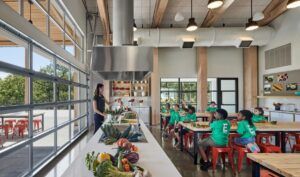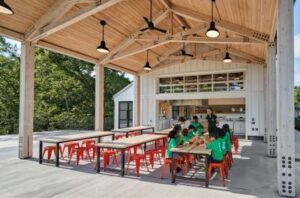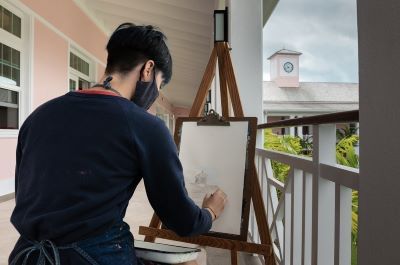The school experience plays an outsize role in students’ lives, shaping mental and physical health as well as academic outcomes. How can school leaders ensure the design of their buildings best supports student wellbeing and success?
According to the architect and education design expert Elizabeth Stoel, a leader at nationally recognized architecture and urban design firm Cooper Robertson, one key strategy involves looking both outside and inside the building walls — and prioritizing holistic opportunities for indoor-outdoor learning and engagement.
Image Courtesy of: Cooper Robertson
“Greater focus on indoor-outdoor spaces and experiences for students is one of the most significant educational design trends in the post-pandemic era,” says Stoel. “This interest reflects an evolving awareness of how children learn and thrive, as well as an urgent youth mental health crisis of increased anxiety and loneliness, fueled by both the pandemic and technology, and a related crisis in youth physical health.”
Indoor-Outdoor Spaces for Physical and Mental Health
Known for designing schools and campuses in settings ranging from New York City and its suburbs to the West Indies and beyond, Stoel and her colleagues can offer valuable insights into the benefits of indoor-outdoor environments and best practices for designing them.

Image Courtesy of: Cooper Robertson
“Educators today recognize the importance of getting outside, disconnecting from technology, and engaging in hands-on work as both a physical and a mental health benefit,” continues Stoel. With this aim in mind, Stoel and her team at Cooper Robertson recommend their educational clients incorporate flexible opportunities for indoor-outdoor learning, gathering and contemplation at a variety of scales. Some of these strategies include:
- Creating rooftop learning gardens, which can be modest or more ambitious in scale. These gardens are feasible even for institutions with smaller buildings and benefit all students, including those who are not athletes, and do not traditionally have many opportunities to get outside during the school day.
- Designing “spill-out” outdoor rooms that connect directly to individual classroom spaces. Cooper Robertson employs this strategy in warm climates, including through the use of verandas at Lyford Cay International Baccalaureate School in the Bahamas. But this can also work as a seasonal approach, even in colder regions, as in the firm’s design for the Edible Academy food education campus at the New York Botanical Garden, where garage-style doors allow for easy indoor-outdoor connections when weather permits.
- Leveraging outdoor space for creative programming, for instance by partnering with organizations that use animals to provide learning and therapeutic opportunities.
Indoor-Outdoor Activity and School Security
Stoel also notes a trend towards incorporating indoor-outdoor activity as part of a more holistic approach to school security, for instance, with new approaches to school design that prioritize a closer engagement with the surrounding neighborhood fabric — including through visible, active outdoor spaces that serve as a buffer between the school and street. These spaces can be made open to the community after hours and on weekends, reinforcing the sense that a school is a community resource for everyone.

Image Courtesy of: Cooper Robertson
“While it may seem counterintuitive,” says Stoel, “being more visible to the surrounding community can actually make school populations safer and also increase students’ sense of security. Schools that are less fortress-like and more physically connected to their surrounding communities benefit from an eyes-on-the-street approach, where neighbors, students, staff, and faculty all know each other, and students know that neighbors can see what’s going on and make sure everything is okay.”
Feature Image Courtesy of: Cooper Robertson
View the original article and our Inspiration here


Leave a Reply